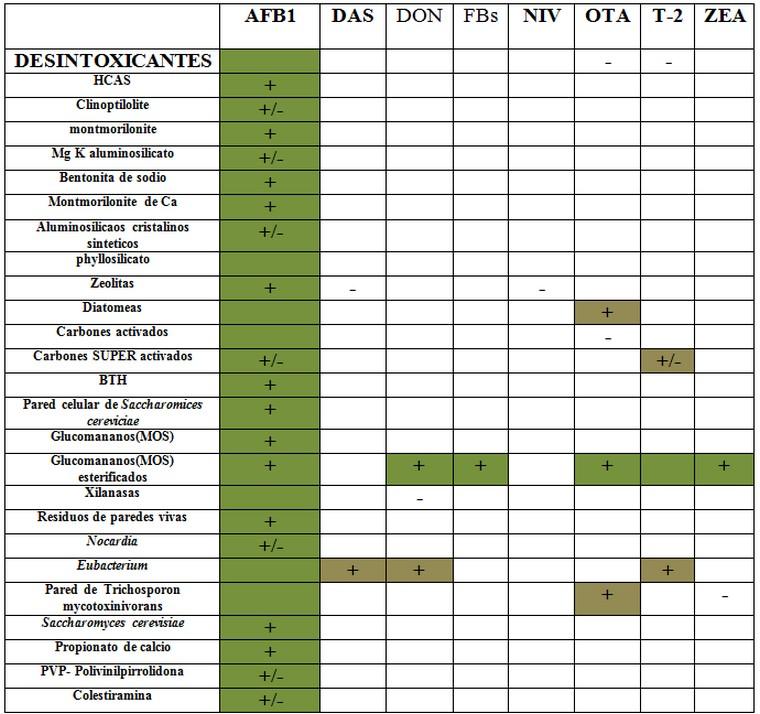Reducción de los efectos tóxicos de los alimentos, mediante la utilización de los Adsorbentes de Micotoxinas - Revisión
En la última década los reportes mundiales indican que más del 70% de las muestras de materias primas analizadas (maíz, sorgo, trigo, cebada, soya, ensilajes, subproductos de maíz, trigo y arroz) están contaminadas con una micotoxina, y el 40% con más de una [1], Las Micotoxinas son el producto secundario del metabolismo de los hongos, Los efectos perjudiciales dependen de la naturaleza y concentración de la toxina en la dieta, edad, etapa productiva, tiempo de exposición, estado nutricional y de salud del ave al momento de recibir el alimento contaminado[1,2] Una de las característica más importante, es que poseen un bajo peso molecular [3]
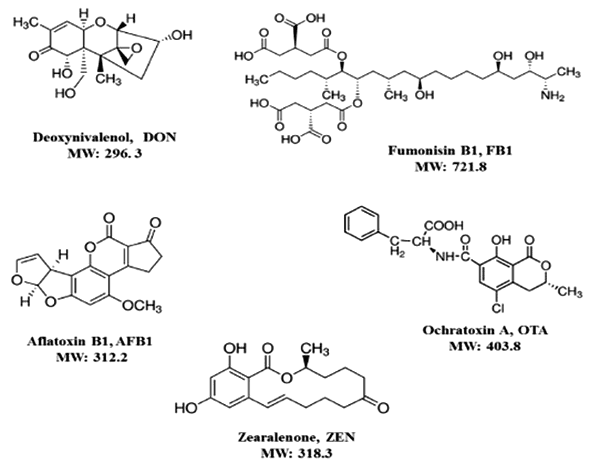
Fig. 1. Estructura química de la micotoxinas (MW: Peso molecular).
Las Micotoxinas en los animales son producidas por tres géneros de hongos: Aspergillus Spp (Aflatoxinas (AFs) y Ocratoxinas A (OTA)), PeniciliumSpp (OTA), y Fusarium Spp ((FBs), Zearalenona (ZEN)). [4].
Las Aflatoxinas (AFs) son moléculas hidrofilicas, producidas por los hongos del género Aspergillus Spp. Dentro de este grupo la AFB1 es la micotoxina con mayor capacidad de producir efectos carcinogénicos en el hígado por esto está clasificado por la IARC (Agencia internacional de investigación para el cáncer), Como grupo1 [7]. La temperatura óptima para que se desarrollen los Aspergillus Spp es de 10-12 ºC, La actividad de agua (AW) necesaria para iniciar su desarrollo y producir micotoxinas es de 0.75- 0.83 [8], El Mecanismo de acción está clasificado como genotoxico causando cambios genéticos por la ruptura en la cadena de DNA, generando un cambio oxidativo en la células que al final conduce a un cáncer, dicha mutación altera la posición de la proteína p53 [9], En el hígado causa: HIGADO GRASO y/o friable. Por degeneración en los hepatocitos se presenta necrosis hepática, alteraciones en el conducto biliar, hay disminución del tiempo de coagulación en sangre y fragilidad capilar [10].
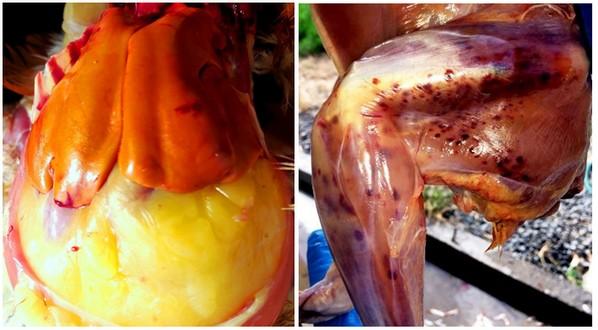
Imagen N° 1.Hígado graso y hemorragias subcutáneas en ponedoras comerciales de 48 Sem de edad, con 44 pbb de aflatoxinas en maíz (laboratorio de I&D Nutritec-Colombia/2018).
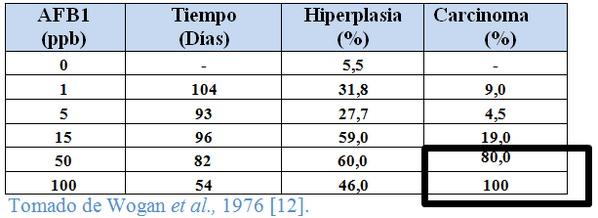
En la industria moderna de producción de proteína blanca (Carne de pollo, carne de cerdo, y producción de huevos), para el control de micotoxinas más que los informes de prevalencia de sustancias toxicas, Es más importante cuantificar los niveles de contaminación específicas de las micotoxinas, de sus efectos según sus dosis, para poder establecer las estrategias de control, La herramienta para sustentar el concepto anterior está dada por Hormesis, que se define como un fenómeno de respuesta a la dosis, caracterizado por una estimulación a dosis baja y una inhibición a dosis alta, la curva de respuesta está representada por una forma de U invertida [13].
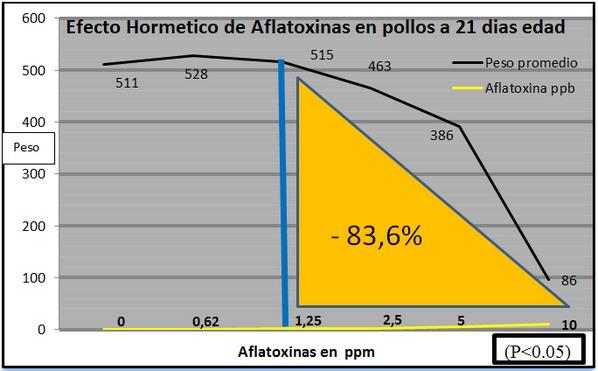
Efecto hormetico en pollos de engorde a los 21 días de edad. Huff et al., 1986
Las Ocratoxinas(OTA) son micotoxinas Nefrotóxicas, que causan toxicidad renal poseen propiedades carcinogénicas, Teratogénicas, inmunotoxicas. Esta toxina ha sido clasificada por la IARC en el grupo 2B, como posiblemente carcinogénica para humanos [7], En animales se ha demostrado que luego del consumo prolongado OTA se presenta una nefropatía por degeneración del túbulo contorneado de la nefrona, seguido por un deterioro de la membrana basal y una hialinizacion glomerular [15]
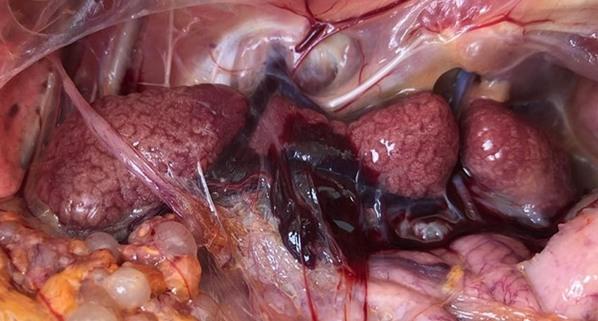
Imagen N2. Hipertrofia renal en aves ponedoras de 44 semanas de edad. (Prueba cuantitativa/Neogen/alimento 50ppb OTA) Lab Nutritec.
Los tricoticenes son producidos por el género Fusarium, el cual produce más de 20 metabolitos. Convirtiéndose en hidroxi- tricoticene T-2 el más abundante, Los tricoticenes son un toxico muy peligroso, debido a su potencial de absorción de los metabolitos en el tracto gastrointestinal, Piel, Riñones, Hígado, y en las células madres del sistema inmune hematopoyético [19]
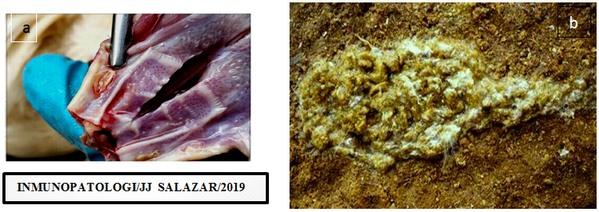
Imagen Nº 3. (a) Ulcera en paladar por T-2 (b) heces diarreicas por T-2 Dx- Neogen
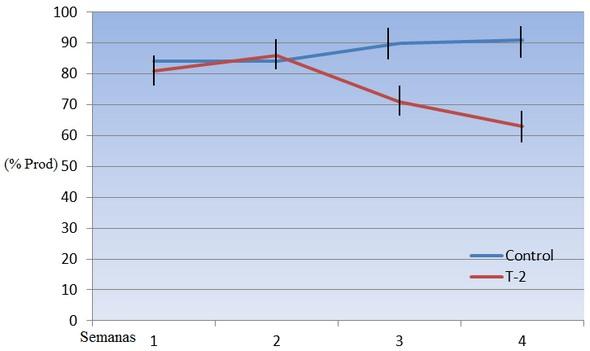
El objetivo principal de los efectos tóxicos de la T-2 Toxina in vivo es el hígado, porque se inhibe la síntesis de proteína, reduciendo la cantidad de enzimas necesarias para el metabolismo de las sustancias toxicas induciendo per oxidación lipídica e incrementando la actividad de la glutatión reductasa [26], Por otro lado los hepatocitos en estados de intoxicación crónicos sufren un deterioro en el metabolismo de las grasas presentado gran cantidad de gotas de lípidos intracitoplasaticos [26].
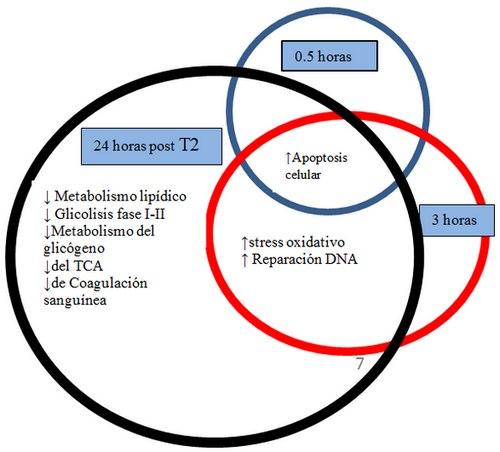
Figura N° 3. Resumen de los daños causados en el hígado luego del consumo continúo de 10 ppm de T-2 en ratas a 0.5, 3.0, 24 horas post consumo. Shinosuka et al., 2005 [27].
El Deoxinivalenol (DON), Pertenece a le grupo B de los tricoticenes tiene como característica que pertenece a las micotoxinas que causan toxicidad aguda en la aves, El interés en esta micotoxina radica su alta prevalencia en los cereales. El DON es conocido como VOMITOXINA, y sus efectos son rechazo de alimento, pérdida de peso, disminución de la eficacia en los nutrientes, Ulceras en el tracto intestinal, vómito, Diarrea sanguinolenta, Dermatitis severa acompañada de hemorragias en la piel [23]
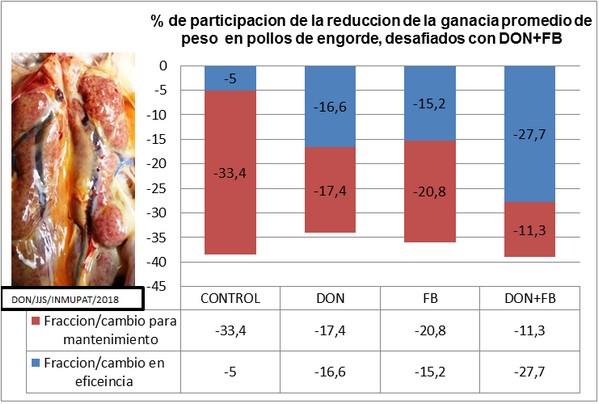
Figura Nº 4. Participación en la reducción de la ganancia de peso debida al mantenimiento y reducción en la participación debida a la eficiencia alimenticia. Grenier et al., 2016 [31]
La Zearalenona es una toxina estrogénica no-esteroidal producida por ciertos Fusarium Spp, Algunos de los metabolitos, pueden comprometer la competitividad de la unión a los receptores de los estrógenos y causar problemas reproductivos, causando una disfunción, especialmente en reproductoras, disminuyendo la fertilidad y aumentando los abortos, además reduciendo la cantidad espermática [32], En los reportes científicos actuales como el hecho por Boudergue et al.,2009 [33] se informa que la mayoría de las aves son muy resistentes a esta toxina, y basados en estudios experimentales los primeros signos de intoxicación se observan a partir de 100.000ppb.
Las aves y los bovinos, son más resistentes Fumomisinas (FB1), los síntomas de intoxicación pueden ser disminución del consumo, ceguera seguida de convulsiones, y muerte después de varia horas de consumo del alimento contaminado [34], Basado en la evidencia toxicológica de la FB1esta clasificada en el grupo 2B de la IARC por causar efectos carcinogénicos [7], el hígado y el riñón son los dos órganos objetivo de la toxina FB1 [34].
La prevención de la contaminación de las materias primas, es el primer elemento para controlar la contaminación de los granos, sin antes mencionar que es necesario tener presente los límites mínimos presentes en los alimentos para las aves, el Dr. Mallman C.A [36] en los trabajos realizados en la universidad de Sta. Maria in vivo en aves reporto dichos parámetros.

LAMIC (Laboratorio para diagnóstico de micotoxinas Brasil, 2008) [36]. AFLA: Aflatoxinas, OCRA: Ocratoxinas, T-2: Tricoticenes, FUM: Fumomisinas, DON: Deoxinivalenol, DAS: Diacetoxyscirpenol (Tricoticene tipo A)
Aproximadamente 100 países han desarrollado técnicas para establecer los límites para la presencia de las micotoxinas, dicha regulación presenta diferencias entre las comidas, alimentos y materias primas para el consumo animal [37].
Micotoxina | Alimento/Comida/Materia prima | (ppb) |
AFB1 | Materias primas | 5-20 |
OTA | Materias primas-cereales-productos de cereales | 100 |
DON | Cereales con excepción del Maiz | 8.000 |
FB1, FB2 | Maíz y Productos del Maiz | 20.000 |
ZEA | cereales | 2.000 |
T-2, HT-2 | cereales | 250 |
Las Intoxicaciones causadas por los hongos son de un origen multicausal. Las estrategias de prevención para la contaminación con hongos se deben llevar a cabo de una forma integrada en la cadena de producción de los granos, puesto que la contaminación puede ocurrir en el periodo de producción de las plantas o en el tiempo de almacenamiento de la materia prima; esas recomendaciones están divididas en dos partes: las basadas en las buenas prácticas de producción (BPM), y la otra es la aplicación del sistema de análisis Hazard o análisis de los puntos críticos de control (HACCP)[40].
La comisión de regulación de la unión europea (EC) No. 386/2009 del 12 de Mayo de 2009, Define los nuevos grupos funcionales de aditivos para alimentos para la producción animal como: Sustancias para la reducción de la contaminación de los alimentos con micotoxinas, Substancias que pueden reducir, suprimir la absorción, O promover la excreción de micotoxinas o modificar su mecanismo de acción, Dependiendo de su mecanismo de acción estos aditivos pueden actuar reduciendo la biodisponibilidad de las micotoxinas por degradación o transformación, en metabolitos menos tóxicos [41].
Los adsorbentes de micotoxinas (AA), poseen una alta masa molecular, La cual se une a las micotoxinas contenidas en el alimento, sin disociarse en el tubo gastrointestinal del animal, limitando la biodisponibilidad después de la ingestión, las micotoxinas pueden unirse a AA de diferentes formas: Capacidad de unión hidrofobica, captura de hidrógenos, Atracción o repulsión electroestática, o enlaces químicos de captura coordinada [42]
Los agentes biotransformantes (AB), logran la degradación de las micotoxinas en agentes no tóxicos usando las enzimas provenientes de algunas bacterias, paredes bacterianas o hongos, a través de varias rutas, La acetilación, La oxigenación, Oxigenación profunda, Isomerización, Glucosilacion [44].
Los aluminosilicatos constituyen el grupo más abundante de formaciones rocosas minerales en la tierra, La unidad estructural está compuesta de un silicato arcilloso consistente de la combinación de láminas de sílice tetraédricas más aluminios octaédricos unidos por grupos de oxígenos e hidrógenos [42], Los Aluminosilicatos se clasifican en dos grupos por su mecanismo de acción que son los Phyllosilicatos y los Tectosillicatos.
Los HSCAS (Arcillas cálcicas de montmorillonite), actúan como un entero adsorbente selectivo para las AFB1en el tracto gastrointestinal del animal, disminuyendo la biodisponibilidad de la micotoxinas [47,48]
La pared celular derivada del Saccharomices cereviciae también es usado como un aditivo adsorbente de micotoxinas, La conformación de la pared de levadura consiste principalmente de proteínas y carbohidratos, la fracción de carbohidratos está compuesta de glucosa, Manosa, N-Acetylglucosamina [49], Los β-glucanos (1→3) (1→6), y los Mananos son los dos principales azucares contenidos en la pared de la levadura del Saccharomices cereviciae [49], [Ver Figura N4].
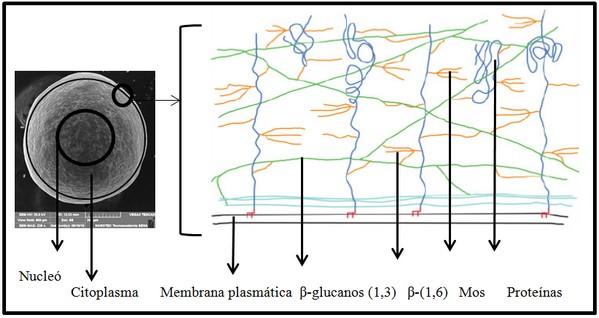
Bowman et al., 2006 [50]

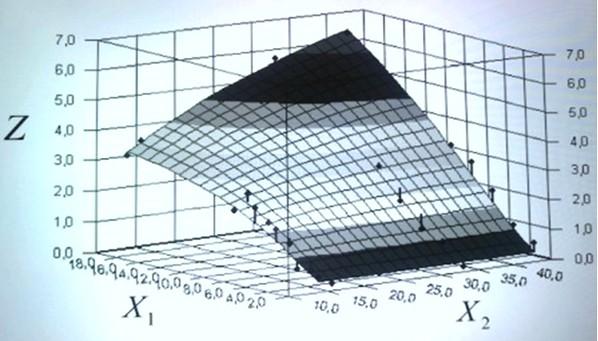
(X1) Cantidad de ZEA, (X2) Cantidad de β-glucanos (1→3) (1→6), (Z) Cantidad de micotoxina adsorbida. Yiannikouris, et al., 2004[55]
Dentro de los polímeros que son usados como adsorbentes de micotoxinas se encuentra la Colestiramina, resinas de intercambio anionico que se dividen en dos: Dibinil-benceno estireno y la Polivinilpirrolidona (PVP), es un polímero altamente anfoterico [56], La colestiramina es un amonio cuaternario insoluble, el cual se une fuertemente a varios compuestos anionicos o catiónicos, se ha comprobado su efecto como adsorbente in vitro frente a OTA, ZEN, y FBs [57] (ver tabla N4).
Uno de los objetivos primordiales de este artículo de revisión de literatura científica, Es aclarar el comportamiento de los agentes adsorbentes de micotoxinas, se presentan diferencias cuando se evalúan in vivo e in vitro, ya que la capacidad de unión a las micotoxinas se ve afectado por los jugos gástricos y el pH intestinal, que pueden disminuir su efectividad [58].
Adsorbente | Adsorción OTA (%) |
Levadura de cerveza (DY) | 41.63 +/- 0.64? |
Pared de Levadura (CW) | 57.83 +/- 1.03? |
Extracción de β-glucan alcalino (AG) | 25.53 +/- 1.92? |
Extracción de β-glucan soluble (WG) | 55.22 +/- 1.06? |
Β-glucan (Saccharomices cereviciae)(CG) | 56.37 +/- 0.67?? |
Algunos autores han estudiado el uso ve varios AA en combinación que poseen propiedades estructurales diversas y que son herramientas versátiles con las que se pueden disminuir el impacto de la Co-contaminación de las micotoxinas en los alimentos para animales, como el trabajo realizado por Avantaggiato et al., 2007, [62], donde se observó el efecto in vivo de , Gluco- mánanos esterificados, EGM (0.05%), Aluminosilicatos de sodio y cloro hidratados, HSCAS (0.02%) y una combinación de ambos (EGM+HSCAS 0.01%); el resultado fue una mejora significativa en el peso, la conversión y la retención de lípidos, siendo considerado como un tratamiento efectivo.
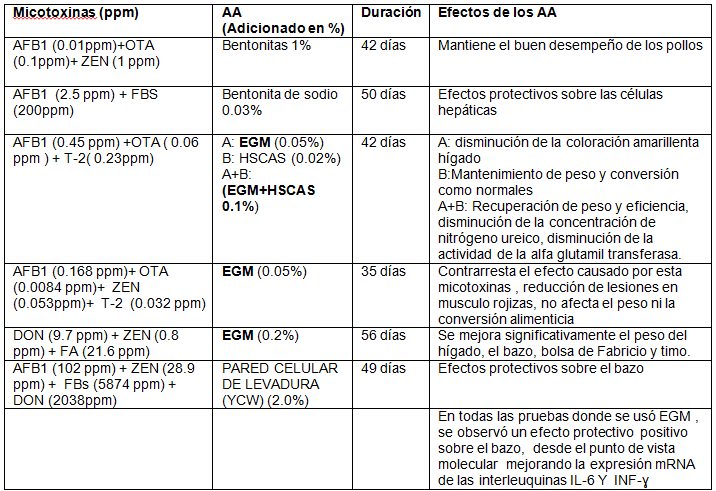
(AFB1) Aflatoxinas, (OTA) Ocratoxina, (ZEN) Zearalenona, (FBs) Fusaritoxinas, (DON) 3-acetyl deoxinivalenol, (HSCAS) Aluminosilicatos hidratados de sodio y calcio, (EGM) Glucomananos esterificados, (YCW) Pared de levadura. Donat. P et al., 2018[63].
Los autores de esta revisión de literatura declaran que no hay conflicto de intereses.
[1] Zaviezo, D. (2010). La problemática de micotoxinas en cerdos. Memorias X Congreso Asociación latinoamericana veterinarios especialistas en cerdos (ALVEC).Mendoza.
[2] Mallmann, C.A. and Dilkin, P. (2011). Mycotoxins and Mycotoxicosis in Swine. Translated and edited by G. Zaviezo and D. Zaviezo. Special Nutrients edition. Miami, FL USA. 7. Zaviezo, D. 2008. Target organs: critical in the scientific evaluation of mycotoxin inactivators. Proceedings of the 5th Conference World Mycotoxin Forum. pp 80-81. The Netherlands.
[3] Vila-Donat. P., Marin S., Sanchis.V., Ramos .A.J (2018). A Review of the mycotoxin adsorbing agents, With an emphasis on their multi-binding capacity, for animal feed decontamination. Food and chemical Toxicology . 114. 246-259.
[4] Marín, S., Ramos, A.J., Cano-Sancho, C., Sanchis, V., (2013). Mycotoxins: occurrence, toxicology, and exposure assessment. Food Chem. Toxicol. 60, 218–237
[5] Medina, A., Rodríguez, A., Sultan, Y., Magan, N., (2015). Climate change factors and Aspergillus flavus: effects on gene expression, growth and aflatoxin production. World 1Mycotoxin J. 8, 171–179
[6] Mallmann, C.A. and Dilkin, P. 2011 Mycotoxins and Mycotoxicosis in Swine. Translated and edited by G. Zaviezo and D. Zaviezo. Special Nutrients edition. Miami, FL USA. 7. Zaviezo, D. 2008. Target organs: critical in the scientific evaluation of mycotoxin inactivators. Proceedings of the 5th Conference World Mycotoxin Forum. pp 80-81. The Netherlands
[7] IARC, 1993. International Agency for Research on Cancer. Monographs on the Evaluation of Carcinogenic Risks to Humans, Some Naturally Occurring Substances, Food Itemsand Constituents, Heterocyclic Aromatic Amines and Mycotoxins, vol. 56 International Agency for Research on Cancer, Lyon.
[8] Hellestine, C.W 1976. Condition Leding of Micotoxin Contamination in Food Feeds on Micotoxin other fungal Related Food Problems. American Chemical society. Washington D.C pp 122
[9] Sharma RA and Farmer PB: Biological relevance of adduct detection to the chemoprevention of cancer. Clin Cancer Res 10: 4901-4912, 2004.
[10] Zaviezo, D. y Contreras, M. (2005) Impacto de hongos y micotoxinas en las aves. Industria Avícola 52 (7):19-22
[11] Streit, E., Naehrer, K., Rodrigues, I., Schatzmayr, G., 2013. Mycotoxin occurrence in feed and feed raw materials worldwide: long-term analysis with special focus on Europe and Asia. J. Sci. Food Agric. 93, 2892–2899.
[12] Wogan, G.N. (1976) Metabolism and biochemIcal effects of aflatoxins. ln: Goldblatt, L.A., ed. Ajlatoxin. Scientific Background, Control and Implications, New York, Academie Press, pp. 151-186
[13] https:// Wikypedia.org/Hormesis
[14] Huff, W.E., L.F. Kubena, R.B Harvey, D.E. Corrier, and H.H. Mollenhauer. 1986. Progression of aflatoxicosis in broiler chickens. Poult. Sci. 65: 1891-1899
[15] Pfohl-Leszkowicz, A., Hadjeba-Medjdoub, K., Ballet, N., Schrickx, J., Fink-Gremmels, J., 2015. Assessment and characterisation of yeast-based products intended to mitigate ochratoxin exposure using in vitro and in vivo models. Food Addit. Contam. 32, 604–616
[16] Petrik, J.; Zanic-Grubisic, T.; Barisic, K.; Pepeljnjak, S.; Radic, B.; Ferencic, Z.; Cepelak, I. Apoptosis and oxidative stress induced by Ochratoxin A in rat kidney. Arch. Toxicol. 2003, 77, 685–693.
[17] Creppy, E.E.; Roschenthaler, R.; Dirheimer, G. Inhibition of protein synthesis in mice by Ochratoxin A and its prevention by phenylalanine. Food Chem. Toxicol. 1984, 22, 883–886.
[18] Matejova, I., Svobodoba, Z., Vakula, J., Mares, J., Modra, H., 2017. Impact of mycotoxins on aquaculture fish species: a review. J. World Aquacult. Soc. 48, 186–200.
[19] Manish Adhikari , Bhawana Negi, Neha Kaushik, Anupriya Adhikari, Abdulaziz A. Al-Khedhairy, Nagendra Kumar Kaushik1 and Eun Ha Choi 2017, T-2 mycotoxin: toxicological effects and decontamination strategies Oncotarget, 2017, Vol. 8, (No. 20), pp: 33933-33952
[20] Hossam EDMO 2013 . Mycotoxins-Induced Oxidative Stress and Disease, Mycotoxin and Food Safety in Developing Countries. Makun, H.A. InTech, Croatia. 2013: 63?92
[21] Devreese M, Backer P De, Croubels 2013 . Different methods to counteract mycotoxin production and its impact on animal health. Vlaams Diergen Tijds. 82: 181-190.
[22] Akande KE, Abubakar MM, Adegbola TA, Bogoro SE 2006 . Nutritional and health implications of mycotoxins in animal feeds: A review. Pak J Nutr. 5: 398-403
[23] Bryden, W.L., 2012. Mycotoxin contamination of the feed supply chain: implications for animal productivity and feed security. Anim. Feed Sci. Technol. 173, 134–158
[24] Wyatt R.D., Doer J.A., Hamilton P.B., Burmeister H.P (1975). Egg Production, Shell Thickness, and Other Physiological Parameters of Laying Hens Affected by T-2 Toxin. Vol. 29, 5, 641-649
[25] Pier AC, Richard JL, Cysewski SJ. The implications of mycotoxins in animal disease. J Am Vet Med Assoc 1980; 176:719-24.
[26] Smith TK1992 . Recent Advances in the Understanding of Fusarium trichothecene mycotoxicoses. J Anim Sci; 7 0:3989-93.
[27] Shinozuka, J., Miwa, S., Fuj imura, H., Toriumi, W. and Doi, K (2005). Hepatotoxicity of T-2 toxin, trichothecene mycotoxin.
[28]Yunus, A.W., Valenta, H., Abdel-Raheem, S.M., Döll, S., Dänicke, S., Böhm, J., 2010. Blood plasma levels of deoxynivalenol and its de-epoxy metabolite in broilers after a single oral dose of the toxin. Mycotoxin Res. 26, 217–220.
[30] Awad, W.A., Böhm, J., Razzazi-Fazeli, E., Zentek, J., 2006. Effects of feeding deoxynivalenol contaminated wheat on growth performance, organ weights and histological parameters of the intestine of broiler chickens. J. Anim. Physiol. Anim. Nutr. 90, 32–37.
[31] Grenier. B., Dohnal I., Shanmugasundaram R., Eicher S , Ramesh K. Selvaraj Schatzmayr Gand Todd J. Applegate, (/2016) Susceptibility of Broiler Chickens to Coccidiosis When Fed Subclinical Doses of Deoxynivalenol and Fumonisins—Special Emphasis on the Immunological Response and theMycotoxin Interaction.Toxin 8, 231
[32] Zinedine, A., Soriano, J.M., Moltó, J.C., Mañes, J., 2007. Review on the toxicity, occurrence, metabolism, detoxification, regulations and intake of zearalenone, an oestrogenic mycotoxin. Food Chem. Toxicol. 45, 1–18. P. Vila-Donat et al. Food and Chemical Toxicology 114 (2018) 246–259
[33] Boudergue, C., Burel, C., Dragacci, S., Favrot, M.C., Fremy, J.M., Massimi, C., Prigent, P., Debongnie, P., Pussemier, L., Boudra, H., Morgavi, D., Oswald, I., Perez, A., Avantaggiato, G., 2009. Review of Mycotoxin-detoxifying Agents used as Feed Additives: Mode of Action, Efficacy and Feed/Food Safety. External Scientific Report Submitted to EFSA Available on: https://www.efsa.europa.eu/en/supporting/pub/ en-22, Accessed date: December 2017
[34] Morgavi, D.P., Riley, R.T., 2007. An historical overview of field disease outbreaks known or suspected to be caused by consumption of feeds contaminated with Fusarium toxins. Anim. Feed Sci. Technol. 137, 201–212
[35] Weibking. T.S., Ledoux R.D., Bermudez A.J., Rhottingaus. (1994) Effects of Feeding Fusarium moniliforme Culture Material, Containing Known Levels of Fumonisin Bi, in the Young Turkey PoultPoultry Science 7. 1517-1525
[36] LAMIC (2008) Laboratorio de Análisis Micotoxicológicas UFSM (Universidad Federal de Santa María) Departamento de Zootecnia. Para más información contactar con el Prof. Dr. Carlos Augusto Mallmann (Mallmann@lamic.ufsm.br)
[37] EC, European Commission, 2003. Commission directive 2003/100/EC of 31 october 2003 amending annex I to directive 2002/32/EC of the european parliament and of the council on undesirable substances in animal feed. O_. J. EU. L 285, 33–37.
[38] Wielogórska, E., MacDonald, S., Elliot, C.T., 2016. A review of the e_cacy of mycotoxin detoxifying agents used in feed in light of changing global environment and legislation. World Mycotoxin J. 9, 419–433.
[39] Afssa, 2009. Évaluation des risques liés à la présence de mycotoxines dans les chaînes alimentaires humaine et animale
[40] Awad, W.A., Ghareeb, K., Böhm, J., Zentek, J., 2010. Decontamination and detoxification strategies for the Fusarium mycotoxin deoxynivalenol in animal feed and the effectiveness of microbial biodegradation. Food Addit. Contam. 27, 510–520.
[41] EC, European Commission, 2009. Commission regulation (EC) No. 386/2009 of 12 May 2009 amending Regulation (EC) No. 1831/2003 of the European Parliament and of The Council as regards the establishment of a new functional group of feed additives. Off. J. EU. L 118, 66.
[42] Di Gregorio, M.C., de Neeff, D.V., Jager, A.V., Corassin, C.H., de Pinho Carão, A.C., de Albuquerque, R., de Azevedo, A.C., Fernandes Oliveira, C.A., 2014. Mineral adsorbent for prevention mycotoxins in animal feed. Toxin Rev. 33, 125–135.
[43] Avantaggiato, G., Solfrizzo, M., Visconti, A., 2005. Recent advances on the use of adsorbent materials for detoxification of Fusarium mycotoxins. Food Addit. Contam. 22, 379–388.
[44] Wielogórska, E., MacDonald, S., Elliot, C.T., 2016. A review of the efficacy of mycotoxin detoxifying agents used in feed in light of changing global environment and legislation. World Mycotoxin J. 9, 419–433.
[45] Diaz, D.E., Hagler, W.M., Hopkins, B.A., Whitlow, L.W., 2002. Aflatoxin binders I: In vitro binding assay for aflatoxin B1 by several potential sequestering agents. Mycopathologia, 156, 223-226. Diaz, D.E., Smith, T.K., 2005. Mycotoxin sequestering agents: practical tools for the neutralisation of mycotoxins.
[46] Ramos, A.J., Hernandez, E., 1997. Prevention of aflatoxicosis in farm animals by means of hydrated sodium calcium aluminosilicate addition to feedstuffs: A review. Animal Feed Science and Technology, 65, 197-206
[47] Neeff, D.V., Ledoux, D.R., Rottinghaus, G.E., Bermudez, A.J., Dakovic, A., Murarolli, R.A., Oliveira, C.A.F., 2013. In vitro and in vivo efficacy of a hydrated sodium calcium aluminosilicate to bind and reduce aflatoxin residues in tissues of broiler chicks fed aflatoxin B1. Poultry Sci. 92, 131–137
[48] Harper, A.F., Estienne, M.J., Meldrum, J.B., Harrell, R.J., Diaz, D.E., 2010. Assessment of a hydrated sodium calcium aluminosilicate agent and antioxidant blend for mitigation of aflatoxin-induced physiological alterations in pigs. J. Swine Health Prod. 18, 282–289
[49] Evans, J., Dawson, K., 2000. The ability of Mycosorb to bind toxins present in endophyte-infected tall fescue. Science and Technology in the feed industry
[50] Bowman, S. M. & Free, S. J.(2006). The structure and synthesis of the fungal cell wall. Bioessays 28, 799-808.
[51] https://es.wikipedia.org/wiki/Fuerzas_de_Van_der_Waals
[52] Fruhauf, S., Schwartz, H., Ottner, F., Krska, R., Vekiru, E., 2012. Yeast cell based feed additives: studies on a_atoxin B1 and zearalenone. Food Addit. Contam. 29, 217–231
[53] Pfohl-Leszkowicz, A., Hadjeba-Medjdoub, K., Ballet, N., Schrickx, J., Fin Gremmels, J., 2015. Assessment and characterisation of yeast-based products intended to mitigate ochratoxin exposure using in vitro and in vivo models. Food Addit. Contam. 32
[54] Cavret, S., Laurent, N., Videmann, B., Mazallon, M., Lecoeur, S., 2010. Assessment of deoxynivalenol (DON) adsorbents and characterisation of their efcacy using complementary in vitro tests. Food Addit. Contam. 27, 43–53
[55] Yiannikouris, A., P Jouany, J.P., Bertin., G, 2004. The chemical bonds between mycotoxins and cell Wall components of Saccharomyces cerevisiae have been identified
[56] Avantaggiato, G., Solfrizzo, M., Visconti, A., 2005. Recent advances on the use of adsorbent materials for detoxification of Fusarium mycotoxins. Food Addit. Contam. 22, 379–388
[57] Avantaggiato, G., Havenaar, R., Visconti, A., 2003. Assessing the zearalenone-binding Activity of adsorbent materials during passage through a dynamic in vitro gastrointestinalmodel. Food Chem. Toxicol. 41, 1283–1290
[58] Vekiru, E., Fruhauf, S., Sahin, M., Ottner, F., Schatzmayr, G., Krska, R., 2007. In vestigation of various adsorbents for their ability to bind aflatoxin B1. Mycotox. Res. 23, 27–33
[59] Santos, R.R., Vermeulen, S., Haritova, A., Fink-Gremmels, J., 2011. Isotherm modeling of organic activated bentonite and humic acid polymer used as mycotoxin adsorbents. Food Addit. Contam. 28, 1578–1589
[60] Piotrowska. M & Maesk.A (2015). Saccharomices cereviciae Cell Wall Components as Tools for Ocratoxin A Decontamination. Toxin 7, 1151-1162
[61] Magnoli, A.P., Monge, M.P., Miazzo, R.D., Cavaglieri, L.R., Magnoli, C.E., Merkis, C.I., Cristofolini, A.L., Dalcero, A.M., Chiacchiera, S.M., 2011. Effect of low levels of a flatoxin B-1 on performance, biochemical parameters, and aflatoxin B1 in broiler liver tissues in the presence of monensin and sodium bentonite. Poultry Sci. 90, 48–58
[62] Avantaggiato, G., Havenaar, R., Visconti, A., 2007. Assessment of the multi-mycotoxinbinding efficacy of a carbón aluminosilicate-based product in an in vitro gastrointestinal model. J. Agric. Food Chem. 55, 4810–4819
[63] Donat, P., Martin, S., Sanchis, V., Ramos, A.J (2018). A review of the mycotoxin adsorbing agents, with an emphasis on their multi-binding capacity, for animal feed decontamination, Food and Chemical Toxicology . 247-259
Gracias Eduardo, sugiero hacer un trabajo de revision sitematica de el impacto de las micotoxinas en cerdos, especialmente con la zearalenona.
o hacer un meta analisis del impacto de las Aflatoxinas AFb1 en aves y cerdos.
cordial saludo

En Panamá se habla sobre la relación de las micotoxinas y la disminución de la reproducción en cerdo y ganado, pero a la fecha no se ha realizado un estudio para establecer si son realmente las micotoxinas el problema, ye que fundamentamos el hecho en estudios realizados en México y Brasil pero las condiciones climáticas de ambos países son muy distintas a las nuestras.
Nuevamente gracias por la información brindada y solo nos queda seguir investigando.



Estados Unidos de América

Estados Unidos de América
